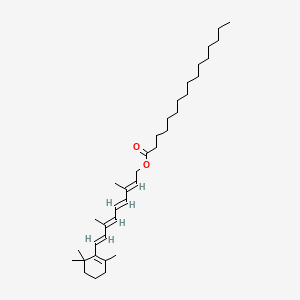| MeSH term | MeSH ID | Detail |
|---|---|---|
| Edema | D004487 | 152 associated lipids |
| Weight Gain | D015430 | 101 associated lipids |
| Cell Transformation, Neoplastic | D002471 | 126 associated lipids |
all-trans-retinyl Palmitate
All-trans-retinyl palmitate is a lipid of Prenol Lipids (PR) class. All-trans-retinyl palmitate is associated with abnormalities such as Wiskott-Aldrich Syndrome.
Cross Reference
Introduction
To understand associated biological information of all-trans-retinyl Palmitate, we collected biological information of abnormalities, associated pathways, cellular/molecular locations, biological functions, related genes/proteins, lipids and common seen animal/experimental models with organized paragraphs from literatures.
What diseases are associated with all-trans-retinyl Palmitate?
all-trans-retinyl Palmitate is suspected in and other diseases in descending order of the highest number of associated sentences.
Related references are mostly published in these journals:
| Disease | Cross reference | Weighted score | Related literature |
|---|
Possible diseases from mapped MeSH terms on references
We collected disease MeSH terms mapped to the references associated with all-trans-retinyl Palmitate
PubChem Associated disorders and diseases
What pathways are associated with all-trans-retinyl Palmitate
There are no associated biomedical information in the current reference collection.
PubChem Biomolecular Interactions and Pathways
Link to PubChem Biomolecular Interactions and PathwaysWhat cellular locations are associated with all-trans-retinyl Palmitate?
There are no associated biomedical information in the current reference collection.
What functions are associated with all-trans-retinyl Palmitate?
There are no associated biomedical information in the current reference collection.
What lipids are associated with all-trans-retinyl Palmitate?
There are no associated biomedical information in the current reference collection.
What genes are associated with all-trans-retinyl Palmitate?
There are no associated biomedical information in the current reference collection.
What common seen animal models are associated with all-trans-retinyl Palmitate?
There are no associated biomedical information in the current reference collection.
NCBI Entrez Crosslinks
All references with all-trans-retinyl Palmitate
Download all related citations| Authors | Title | Published | Journal | PubMed Link |
|---|---|---|---|---|
| Jenning V et al. | Vitamin A-loaded solid lipid nanoparticles for topical use: drug release properties. | 2000 | J Control Release | pmid:10742573 |
| Croquet V et al. | Hepatic hyper-vitaminosis A: importance of retinyl ester level determination. | 2000 | Eur J Gastroenterol Hepatol | pmid:10750659 |
| Relas H et al. | Effect of stanol ester on postabsorptive squalene and retinyl palmitate. | 2000 | Metab. Clin. Exp. | pmid:10778871 |
| Goodman GE | Prevention of lung cancer. | 2000 | Crit. Rev. Oncol. Hematol. | pmid:10789492 |
| Hu X et al. | Intestinal absorption of beta-carotene ingested with a meal rich in sunflower oil or beef tallow: postprandial appearance in triacylglycerol-rich lipoproteins in women. | 2000 | Am. J. Clin. Nutr. | pmid:10799380 |
| Guerci B et al. | Relationship between altered postprandial lipemia and insulin resistance in normolipidemic and normoglucose tolerant obese patients. | 2000 | Int. J. Obes. Relat. Metab. Disord. | pmid:10805504 |
| Pedersen-Bjergaard S et al. | Microemulsion electrokinetic chromatography in suppressed electroosmotic flow environment. Separation of fat-soluble vitamins. | 2000 | J Chromatogr A | pmid:10823515 |
| Kuwata T et al. | Vitamin A deficiency in mice causes a systemic expansion of myeloid cells. | 2000 | Blood | pmid:10828015 |
| Omenn GS | Chemoprevention of lung cancer is proving difficult and frustrating, requiring new approaches. | 2000 | J. Natl. Cancer Inst. | pmid:10861300 |
| van Zandwijk N et al. | EUROSCAN, a randomized trial of vitamin A and N-acetylcysteine in patients with head and neck cancer or lung cancer. For the EUropean Organization for Research and Treatment of Cancer Head and Neck and Lung Cancer Cooperative Groups. | 2000 | J. Natl. Cancer Inst. | pmid:10861309 |
